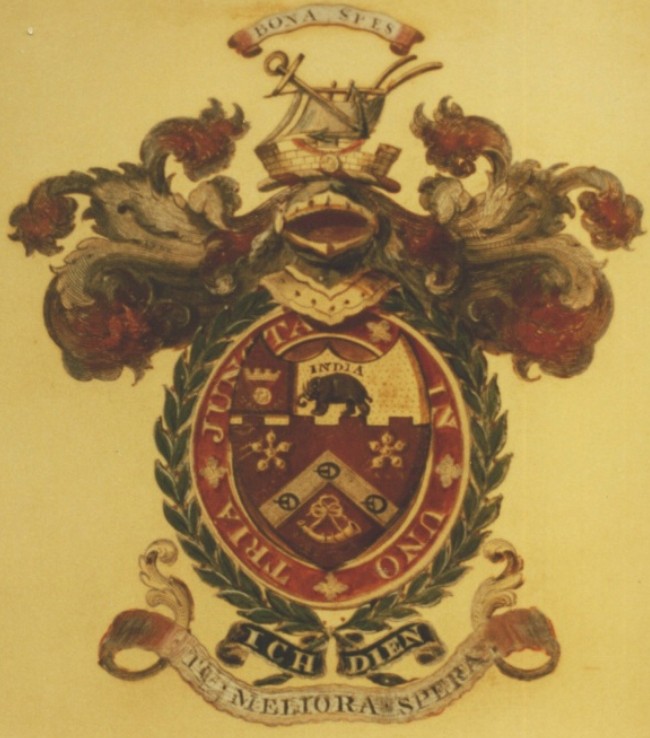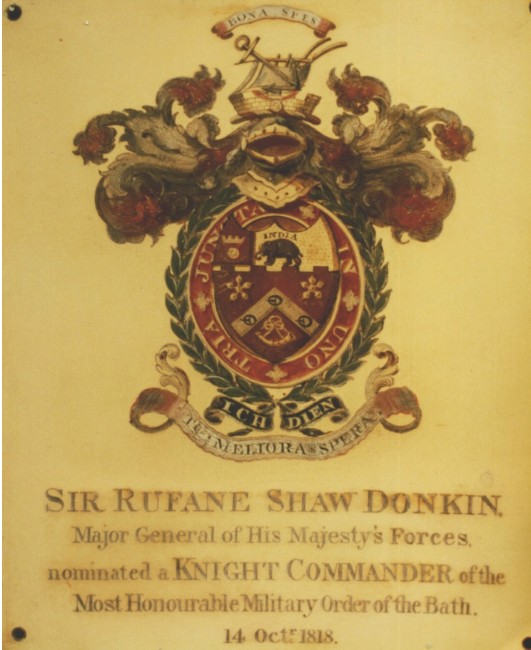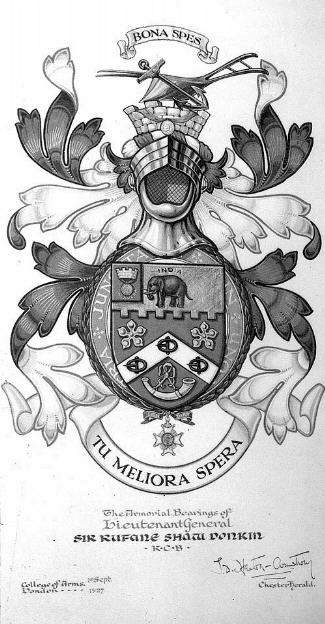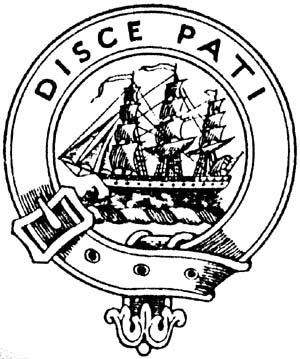

Sir Rufane Donkin
by Mike Oettle
ALTHOUGH General Sir Rufane Shaw Donkin left no descendants at the Cape and only spent a couple of years in the colony, the adoption of his arms in 1861 by the town of Port Elizabeth (which he had founded in 1820) has left an abiding influence in the heraldry of the Algoa Bay region.
Rufane Donkin was born in 1772 or ’73 – the date September 1772 appears on his gravestone, but his parents were only married in that year, and his school records reflect him as being born in ’73 – and died on 1 May 1841. He was named for his father’s superior officer, General William Rufane, who came from a family of French origin. The surname appears to have been Ruffane or Ruffine before being anglicised.

His arms may be blazoned:
Arms: Gules, a chevron argent charged with three buckles sable between, in chief, two cinquefoils, and in base, a bugle horn embellished and stringed, all or. Augmentation of honour: Upon a chief embattled argent, an Indian elephant proper beneath the word INDIA in gold.
Additional augmentation: Upon a canton gules, a representation of the Peninsular Gold Cross suspended from a mural crown; the medal encircled by the word “Talavera” in gold. The shield surrounded by the collar of the Order of the Bath, gules fimbriated and embellished or, bearing the words Tria juncta in uno, as well as a laurel wreath. Suspended from both is the cross of the Order of the Bath.
Crest-wreath and mantling: argent and gules.
Crest: upon a mural crown or, masoned sable, resting on a wreath of the colours, an anchor and a plough in saltire, with the Peninsular Gold Cross suspended by a ribbon gules from the battlements of the crown.
Personal mottos: On a scroll beneath the shield the words Tu meliora spera, and on a second scroll above the crest the words Bona Spes.

The shield is surrounded by the collar of the Bath, and in addition to his personal motto there is the motto of the order, Tria juncta in uno (Three joined in one; an expression of the doctrine of the Trinity).
The motto Tu meliora spera is an injunction to seek out in hope things that are better. The other motto, Bona spes, has the same meaning (although doubtless a very different derivation) as the motto shared by the Cape Colony, the Cape Province, the Western Cape Province and the City and University of Cape Town.
The stall plate version of the arms includes the motto Ich dien (“I serve”, motto of the Prince of Wales), which was also part of the insignia of the Order of the Bath.
The illustration above right is shows the arms as displayed on the enamelled brass plate (known as a stall plate) which in Sir Rufane’s lifetime was placed on his stall in the chapel of the Order of the Bath, of which he was a knight commander (the full plate is shown at left). The chapel, also known as the Henry VII Chapel, is behind the high altar in Westminster Abbey in London.
The stall plate was purchased by the Port Elizabeth Museum, now called Bayworld, in 1980. This image shows that it is in need of restoration, since the red enamel of the main part of the shield has fallen away, leaving a dirty white background.)
The second illustration (below) is an old photograph of a library painting of Sir Rufane’s arms executed in 1927 by a herald painter attached to the College of Arms for the City of Port Elizabeth. The original hung in the Port Elizabeth City Hall and was destroyed in the fire that ruined the interior of that building in 1979.
The chief with its elephant and the word “INDIA” were granted to honour Donkin’s service in India, notably in the successful British campaign against the Mahrattas in 1817-18.

The medal is not named in any of the blazons I have been able to trace, but Robert Laing (editor of Arma, journal of the Heraldry Society of Southern Africa) writes that it is most probably the Peninsular Gold Cross, an award for participants in the so-called Peninsular War fought in Portugal and Spain against Napoleon’s allies. The medal was awarded late in Sir Rufane’s life, since all the British decorations for service in the Napoleonic Wars were subject to a delay of as much as a decade after Napoleon’s defeat. Donkin was a brigade commander in the campaign along the Douro River (in northern Portugal) and played a key role in the capture of the city of Talavera de la Reina, an important gateway to Madrid.
Born in Ireland to a military family, the boy’s family hailed from Northumbria, where it had been established for some 600 years, although its coat-armour reveals it to be a branch of the Scottish family surnamed Duncan.
The Duncans are in turn a branch of Clan Robertson, which is called, in Gaelic, Clann Donnchaidh or Clann Donnachaidh – sometimes written in English as Clan Donnachie. This name apparently means “brown warrior”, although George F Black (The Surnames of Scotland: Their Origin, Meaning and History) offers “fort warrior” as an alternative. Black makes it clear that there were branches of the family in or close to England from quite early on.
Rufane Donkin, then a major-general, was invalided to the Cape of Good Hope from India in 1819 following the Mahratta Campaign. (By the time he left the Cape he had been promoted to lieutenant-general, and became a full general in 1838.) During the Mahratta campaign his wife, Elizabeth, daughter of Dr Markham, Dean of York, died of a fever at Meerut in August 1818, leaving him with an infant son. Gen Donkin was gazetted Knight Commander of the Bath in October that year, which means that his wife was never known as “Lady Donkin”, even though the title was apparently created for him as far back as 1815.
In June 1820 Sir Rufane visited Algoa Bay to to see how the landing of the British settlers was progressing. These notes on his visit are taken from an article written by Margaret Harradine:
“It was Donkin who realised that a port was going to be needed on this part of the coast and took the first steps to establish one, naming this prospective village after his wife. He set aside land on the hill overlooking the bay to be forever an open space and the site of a memorial.
“His choice of a pyramid is not at all unusual for the time and the proportions are those of the memorial to Gaius Cestius in Rome and the architect Hawksmoor’s pyramid in the grounds of Castle Howard in Yorkshire, to name only two, and have nothing whatsoever to do with Egypt. In addition, of course, it was also an uncomplicated structure for the soldiers, who had to build it of the local sandstone.”
The pyramid bears an inscription which is a touching testimony to Donkin’s love for his wife. There is, however, no truth in an often repeated rumour that her heart lies buried under the pyramid. Although he did, in fact, carry her heart away from India, it was buried in England.
The pyramid has been used as a symbol for Port Elizabeth in some coats of arms: Livingstone Hospital, Pearson High School and Lawson Brown High School.
Returning to the Donkin/Duncan family: since coat-armour, like tartan, is tied to a family name, the Duncans have not only a different tartan from the Robertsons, but also a different coat of arms. Since any coat of arms is the property of only one person at any one time, different branches of the family bear different versions of that coat of arms.

The Earl of Camperdown, head of the senior branch of the Duncan family, has for his crest a square-rigged sailing ship, described in one source as “in distress” and in another as “a dismasted ship”.
However, where it appears as a bonnet badge, with the motto Disce pati (“Learn to suffer”), the ship is shown with its masts whole and its sails filled. The sailing ship was granted in 1800 to the first viscount (an admiral) in recognition of his service in the Battle of Camperdown (actually Kamperduin, in the Netherlands) in 1797, an engagement with the fleet of the Batavian Republic. The flag flown by the Dutch commander, Vice-Admiral De Winter, can be seen here.
The ship – in its whole form, more or less as it appears in the bonnet badge – reappears not with Sir Rufane but with the City of Port Elizabeth. Two Port Elizabeth schools have badges derived from this crest, but neither is currently registered as a coat of arms. The crest was also copied from the city arms for the crest of the Standard Bank.
The elephant is Indian (of the species Elephas maximas) and has above it in gold letters the word “INDIA”.
The buckles in Sir Rufane’s arms are horizontally aligned (fesswise, in heraldic language) to the dexter (the right, as seen from behind the shield), while in the city’s arms they are upright (palewise).
One Port Elizabeth school, Pearson High, bears arms in which the shield is divided as in Sir Rufane’s arms, with a chevron and an embattled chief. The colours are entirely different (except that the chevron is also silver and the buckles on it also black). The buckles are also aligned fesswise, as in Sir Rufane’s arms.

Vir Afrikaans, kliek hier
This is largely taken from an article by Mike Oettle, published as “The Arms of Sir Rufane Donkin and the City of Port Elizabeth” in Arma, journal of the Heraldry Society of Southern Africa, Vol 5 No 1. The quotation attributed to Margaret Harradine comes from an article in The Herald, Port Elizabeth, of 22 June 2002. Mrs Harradine is retired from the position of Africana librarian at the Port Elizabeth Central Library.
Illustration sources: photograph of undamaged stall plate provided by Tennyson Smith Bodill; photograph of damaged stall plate by Frankie Simpson; library painting photograph from Newspaper House library, Port Elizabeth.
Scans of the library painting and of Frankie Simpson’s photograph courtesy of the Evening Post.
Comments, queries: Mike Oettle